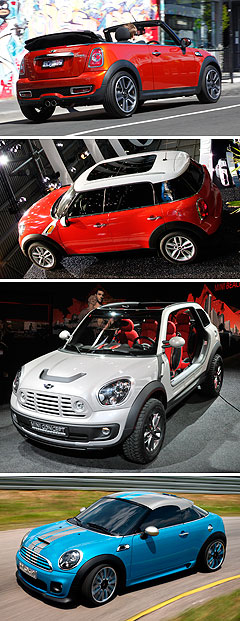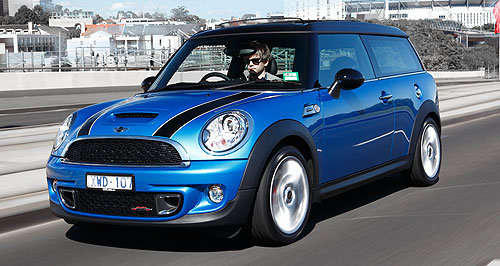News - MiniMini defends market through maturityMaturing: The Mini JCW Clubman is one the models that is helping Mini mature with its customers. BMW says it is ready for the influx of rivals set on stealing the baby Brit’s crown24 Nov 2010 EVOLVING the brand alongside the consumer with new and expanded model offerings, fresh marketing and a more mature tone that loses none of the cheekiness that has been built over the last decade, will help Mini stay on top against new competition. This is all according to Mini manager David Woollcott, speaking to GoAuto at the national launch of the R5X LCI (Life Cycle Impulse) in Melbourne earlier this month. Asked how BMW will respond to the new wave of conceptually similar competition – including the Audi A1 that kicks off at about $1500 cheaper than the $31,500 Cooper – Mr Woollcott said emotion rather than price would prevail for the Mini. "I'm sure you are aware of certain competitors that are looking at our markets to take our sales away, and we're just here to say that ain't going much further," he said. "If you want the emotion, if you want the cheekiness, if you want the go-kart feel, then only we (have) that scenario (with Mini)."Mini’s product planner for Australia, Sue McCarthy, said she welcomed the publicity that the competition was bringing. "History has shown us that more competitors in a segment stimulates market interest and demand … and we don't necessarily view as a negative thing … it’s (actually) a good thing,” she said. “It also keeps everyone on their toes and promotes competition, so bring it on." To the end of October this year, Mini sales are up 15.3 per cent compared with the same time in 2009, and are expected to breach the 2000 unit barrier. 2007 was the best year so far in the modern Mini’s life, finding 2269 buyers.  From top: Mini Cabrio, Mini Countryman, Mini Beachcomber and Mini Coupe Concept. From top: Mini Cabrio, Mini Countryman, Mini Beachcomber and Mini Coupe Concept.BMW has a busy 15-month Mini schedule in Australia with a raft of new products, including the R60 Countryman compact SUV out in February, next August’s R58 Coupe and the R59 Roadster pencilled in for the first quarter of 2012. The Countryman, in particular, is expected to account for between 30 and 40 per cent of sales, and as most are forecast to be conquest volume from other manufacturers, BMW could be looking at achieving over 3500 Mini sales a year before long. Mr Woollcott says that the unique marketing strategy that has defined the Mini since the BMW baby was released in 2001 (“Let’s MINI”) will evolve to something quite different but equally as different for the Countryman. “We are still trying to figure out how to communicate it,” he said. “We wait to find out what’s new – to capture what is going on at the moment and try to reflect what everybody else is thinking in regards to Mini. “But it will be absolutely authentic, exciting and different.” Nevertheless, BMW communications boss Piers Scott said the Mini brand would mature with the customer to retain existing or previous owners who felt that their needs had outgrown the traditional Mini hatch or Clubman. “One thing about the Countryman is that it will have an element of Mini maturing to it, and that is a reflection of the sort of customer that will take an interest in this car,” he said. “We have got Mini enthusiasts who have effectively outgrown the brand purely in a lifestyle sense – be it the arrival of children, a dog or any other new addition for that matter,” he said. “Literally, then, as the customer base matures, the Mini brand needs to do the same. And that will be reflected in the marketing around the country for the Countryman to some degree. But the sense of fun and irreverence certainly won’t be lost. “The other thing that will be coming in as a much stronger emphasis on technology such as Mini Apps, and the various Mini Connected media interface that will be pioneered.” Mr Scott added that not losing sight of what a Mini had become in the decade head start it has enjoyed over the competition was vital in the continuing success of the brand, and put the pressure on the competition to come up with something that did not seem derivative or copycat. “’Simply be Mini’,” he said. “That is the company ethos. Mini has been Mini for 50 years, and it has got its brand well and truly nailed down – and it knows what it is. “Plus the cars have a cult following, so it’s not something we will be missing simply because of the arrival of newer rivals. “If anything the ball is very much in their court all of them define themselves in reference to Mini. I’d say then that the challenge is more for them than us in a brand sense. “Mini has a trump card in terms of heritage, and certainly one of the core elements in the development of the first generation of the new Mini was to retain all of the attributes in terms of the driver experience in terms of what the original car had to offer … today’s car is a bigger car, a more luxurious car, and a more technologically advanced car but in terms of the impressions that it leaves in the heart of the driver, the idea is identical. “And that is a very difficult thing to replicate. I don’t think that you can argue that the (Fiat) 500 has achieved it – it’s attempted to play the heritage but as far as the drive (is concerned) it didn’t have the right car (base) to work with from the start.” Mr Woollcott said that – in the minds of the public – the Mini went far beyond the sum of its parts, and much of that had to do with the sort of marketing undertaken over the last 10 years. “The whole segment is growing, but it about carefully separating the rationale of the product. If you were to describe the Mini as a small three-door car – well, that does not even describe one per cent of what a Mini is. “I think that is what we need to continually keep communicating, and the weight of the brand carries that.”
 Read more23rd of November 2010  First drive: Mini changes to BMW babyMinor spec and efficiency improvements sharpen the Mini Cooper range for 201110th of August 2010  Countryman next stop on Mini journeyMini’s new Countryman is just the latest addition to Mini’s growing family |
Click to shareMini articlesResearch Mini Motor industry news |
||||||||||||









Facebook Twitter Instagram